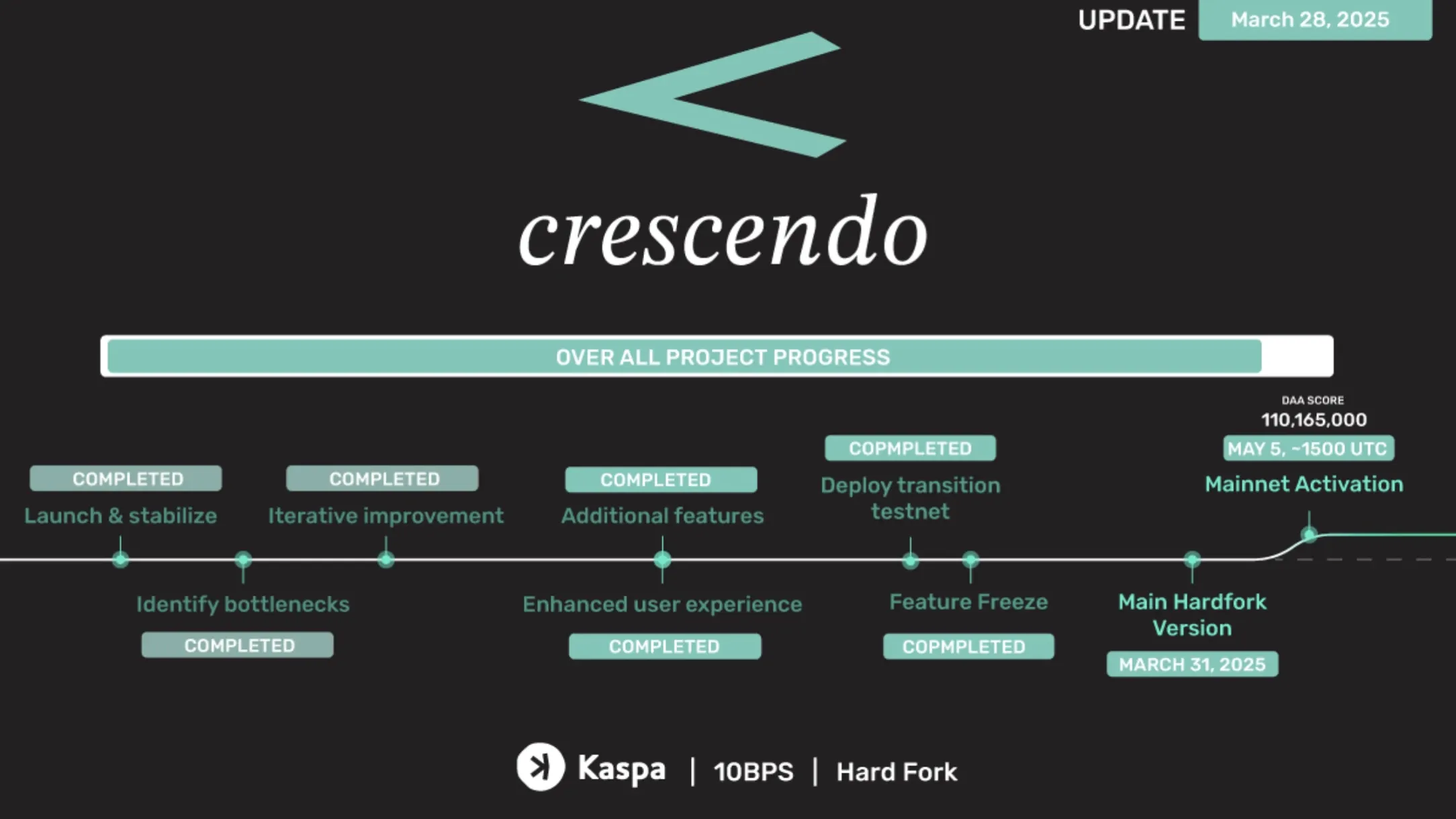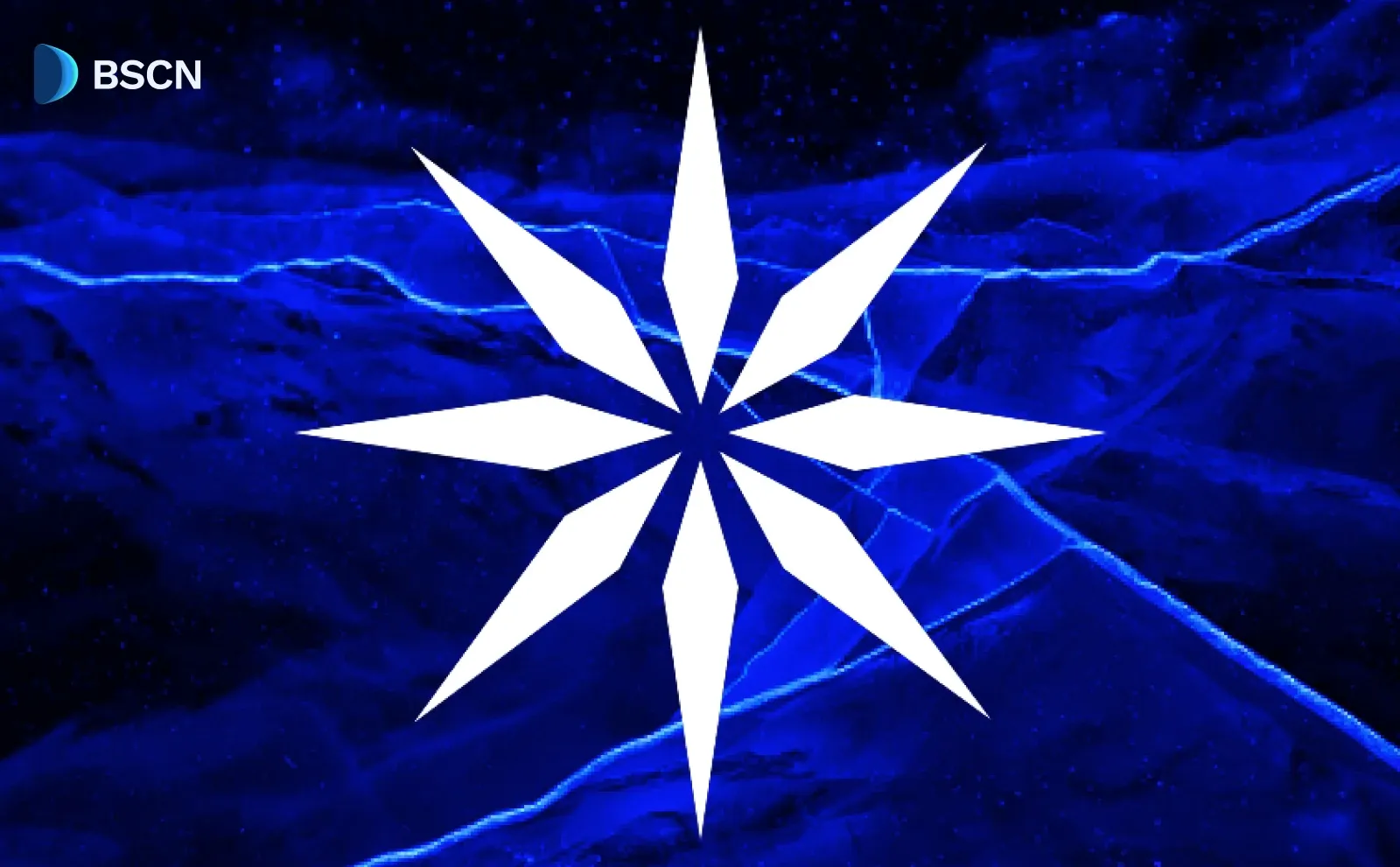Research
(Advertisement)
Kaspa Crescendo Update: Massive Mainnet Upgrade Set for May 5

Kaspa is just weeks away from an upgrade that could supercharge the ecosystem and its adoption. Here's the latest update on KAS' Crescendo Hardfork.
UC Hope
March 31, 2025
(Advertisement)
Table of Contents
Kaspa, a leading proof-of-work (PoW) blockchain platform known for its speed and scalability, has reached a significant milestone in its development journey. In a recent update shared on X, the Kaspa team announced the completion of the feature freeze for its Crescendo roadmap, setting the stage for the highly anticipated Main Hardfork Version scheduled for March 31, 2025.
The feature freeze date marks the point at which no additional features will be added to the hardfork, allowing the team to focus on testing, stabilization, and preparation for the main Hardfork version and mainnet development.
The mainnet deployment of this upgrade, dubbed the Crescendo 10BPS Hardfork, is slated for May 5, 2025, at 15:00 UTC. Hence, the feature freeze represents a technical achievement for Kaspa and positions the protocol as a game-changer in the blockchain industry.
A Roadmap to Revolutionize Blockchain Technology
Kaspa’s Crescendo roadmap, first outlined in earlier communications, has been a focal point for the project’s community and developers. As detailed in the X post, the roadmap includes several completed phases: the initial launch and stabilization, identification of bottlenecks, implementation of additional features, activation of Testnet 10 (TN10), and now the feature freeze. Each step has been crucial in preparing the network for the upcoming hardfork, which promises to elevate Kaspa’s capabilities.

The Crescendo 10BPS Hardfork represents a transformative step for Kaspa and the broader blockchain ecosystem. According to the Kaspa team, this hardfork will raise the bar for what “blockchain technology must deliver to be practical for real-world, everyday use.”
“It paves the way for payments and finance to decentralized applications and physical and digital infrastructure, proving that high-speed, decentralized technology can exist—without sacrificing security or decentralization,” the team noted on X.
By increasing the block generation rate to 10 blocks per second (BPS), Kaspa aims to provide unparalleled transaction throughput while maintaining the security and decentralization that define its PoW framework.
Key Features of the Crescendo Hardfork
The Crescendo upgrade introduces several features that expand Kaspa’s utility beyond its role as a peer-to-peer digital currency. Here’s a closer look at the key enhancements:
1. Larger Throughput for Faster Transactions
One of the standout features of the Crescendo hardfork is its ability to handle significantly more transactions without slowing down. With the network now capable of processing 10 blocks per second, Kaspa can support a higher volume of activity, whether sending KAS tokens, making payments, or running applications.
Importantly, this increase in throughput does not come at the expense of speed, cost, security, or decentralization, making Kaspa a viable option for real-world use cases.
2. Payload Support for Expanded Functionality
The Crescendo hardfork introduces payload support, allowing users to attach data to blocks. This capability paves the way for smart contracts and application-specific actions, enabling developers to build various Decentralized Applications (dApps) on the Kaspa network.
3. Support for Arbitrary Applications
With the license for developers to create arbitrary applications, Kaspa is positioning itself as a sandbox for innovation. The protocol’s enhanced capabilities make it suitable for a variety of use cases, including Decentralized Finance (DeFi), traditional finance (TradFi) platforms, enterprise markets, decentralized social media, DAOs, gaming, and identity systems.
This flexibility underscores Kaspa’s ambition to become a foundational layer for the next generation of blockchain applications.
Why the Crescendo Hardfork Matters
The significance of the Crescendo 10BPS Hardfork extends beyond technical improvements. As the Kaspa team noted in their update, this upgrade is a milestone for digital currency itself. By proving that high-speed, decentralized technology can exist without sacrificing security or decentralization, Kaspa is challenging the limitations of traditional blockchain systems.
Kaspa’s underlying technology, the GHOSTDAG protocol, has long been a differentiator for the project. Unlike conventional blockchains that process transactions sequentially, GHOSTDAG enables parallel block creation, allowing for instant transaction confirmations and rapid block intervals.
The Crescendo hardfork builds on this foundation, pushing the network’s block generation rate to new levels while maintaining its core principles of decentralization and security.
What’s Next for Kaspa?
With the feature freeze now complete, Kaspa’s focus shifts to the Main Hardfork Version, which is scheduled to go live on March 31, 2025. This hardfork version implements the consensus changes outlined in the Crescendo Kaspa Improvement Proposal (KIP), a process that involved rigorous testing and community discussion. The next major step is the mainnet deployment on May 5, 2025, activating the 10BPS hardfork across the network.
The Kaspa community has responded enthusiastically to the Crescendo roadmap update. Replies to the X post reflect a sense of excitement and optimism, with users praising the team’s progress and the potential impact of the hardfork. The positive sentiment underscores the strong support Kaspa has garnered as a community-driven, open-source project with no central governance—a model that mirrors the ethos of Bitcoin.
For developers, the Crescendo hardfork opens up new opportunities to build on Kaspa’s infrastructure. The ability to create arbitrary applications and integrate smart contracts positions Kaspa as a launching pad for entrepreneurs and a foundation for enterprise-grade solutions. As the network continues to evolve, it’s likely to attract a growing ecosystem of developers and innovators.
Conclusion
Kaspa’s completion of the Crescendo feature freeze marks a turning point for the protocol as it prepares for the Main Hardfork Version and the subsequent mainnet deployment of the 10BPS hardfork.
With enhanced throughput, payload support, and the ability to support various applications, Kaspa is redefining possibilities in the blockchain space. As the network moves toward becoming the ultimate peer-to-peer currency and settlement layer, it’s clear that Kaspa wants to set a new standard in the DeFi space.
Read Next...
Disclaimer
Disclaimer: The views expressed in this article do not necessarily represent the views of BSCN. The information provided in this article is for educational and entertainment purposes only and should not be construed as investment advice, or advice of any kind. BSCN assumes no responsibility for any investment decisions made based on the information provided in this article. If you believe that the article should be amended, please reach out to the BSCN team by emailing [email protected].
Author
 UC Hope
UC HopeUC holds a bachelor’s degree in Physics and has been a crypto researcher since 2020. UC was a professional writer before entering the cryptocurrency industry, but was drawn to blockchain technology by its high potential. UC has written for the likes of Cryptopolitan, as well as BSCN. He has a wide area of expertise, covering centralized and decentralized finance, as well as altcoins.
(Advertisement)
Latest News
(Advertisement)
Crypto Project & Token Reviews
Project & Token Reviews
Comprehensive reviews of crypto's most interesting projects and assets
Learn about the hottest projects & tokens














